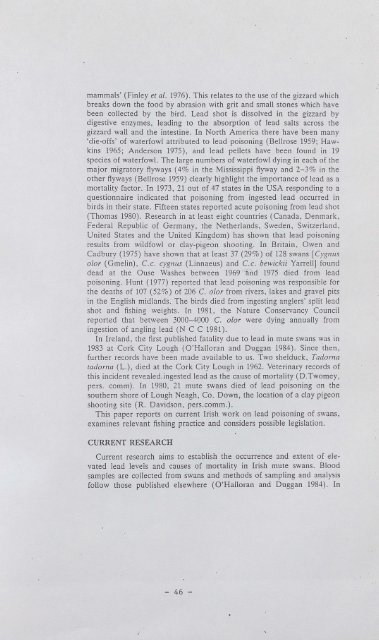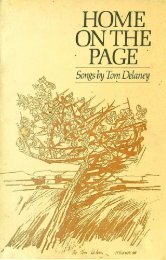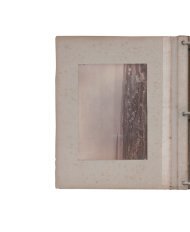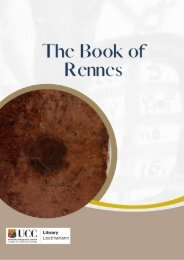Lead Toxicity in Mute Swans
LEAD TOXICITY IN MUTE SWANS Cygnus olor (Gmelin). By JOHN O'HALLORAN A thesis submitted to the National University of Ireland in candidature for the degree of Doctor of Philosophy September 1987
LEAD TOXICITY IN MUTE SWANS
Cygnus olor (Gmelin).
By
JOHN O'HALLORAN
A thesis submitted to the National University of Ireland
in candidature for the degree of Doctor of Philosophy
September 1987
Create successful ePaper yourself
Turn your PDF publications into a flip-book with our unique Google optimized e-Paper software.
mammals' (F<strong>in</strong>ley et al. 1976). This relates to the use of the gizzard which<br />
breaks down the food by abrasion with grit and small stones which have<br />
been collected by the bird. <strong>Lead</strong> shot is dissolved <strong>in</strong> the gizzard by<br />
digestive enzymes, lead<strong>in</strong>g to the absorption of lead salts across the<br />
gizzard wall and the <strong>in</strong>test<strong>in</strong>e. In North America there have been many<br />
'die-offs' of waterfowl attributed to lead poison<strong>in</strong>g (Bellrose 1959; Hawk<strong>in</strong>s<br />
1965; Anderson 1975), and lead pellets have been found <strong>in</strong> 19<br />
species of waterfowl. The large numbers of waterfowl dy<strong>in</strong>g <strong>in</strong> each of the<br />
major migratory flyways ( 4% <strong>in</strong> the Mississippi flyway and 2-3% <strong>in</strong> the<br />
other fiyWays (Bellrose 1959) clearly highlight the importance of lead as a<br />
mortality factor. In 1973, 21 out of 47 states <strong>in</strong> the USA respond<strong>in</strong>g to a<br />
questionnaire <strong>in</strong>dicated that poison<strong>in</strong>g from <strong>in</strong>gested lead occurred <strong>in</strong><br />
birds <strong>in</strong> their state. Fifteen states reported acute poison<strong>in</strong>g from lead shot<br />
(Thomas 1980). Research <strong>in</strong> at least eight countries (Canada, Denmark,<br />
Federal Republic of Germany, the Netherlands, Sweden, Switzerland,<br />
United States and the United K<strong>in</strong>gdom) has shown that lead poison<strong>in</strong>g<br />
results from wildfowl or clay-pigeon shoot<strong>in</strong>g. In Brita<strong>in</strong>, Owen and<br />
Cadbury (1975) have shown that at least 37 (29%) of 128 swans [Cygnus<br />
olor (Gmel<strong>in</strong>), C.c. cygnus (L<strong>in</strong>naeus) and C.c. bewickii Yarrell] found<br />
dead at the Ouse Washes between 1969 ·~nd 1975 died from lead<br />
poison<strong>in</strong>g. Hunt ( 1977) reported that lead poison<strong>in</strong>g was responsible for<br />
the deaths of 107 (52%) of 206 C. olor from rivers, lakes and gravel pits<br />
<strong>in</strong> the English midlands. The birds died from <strong>in</strong>gest<strong>in</strong>g anglers' split lead<br />
shot and fish<strong>in</strong>g weights. In 1981, the Nature Conservancy Council<br />
reported that between 3000-4000 C. olor were dy<strong>in</strong>g annually from<br />
<strong>in</strong>gestion of angl<strong>in</strong>g lead (N C C 1981).<br />
In Ireland, the first published fatality due to lead <strong>in</strong> mute swans was <strong>in</strong><br />
1983 at Cork City Lough (O'Halloran and Duggan 1984). S<strong>in</strong>ce then,<br />
further records have been made available to us. Two shelduck, Tadorna<br />
tadorna (L.), died at the Cork City Lough <strong>in</strong> 1962. Veter<strong>in</strong>ary records of<br />
this <strong>in</strong>cident revealed-<strong>in</strong>gested lead as the cause of mortality (D.Twomey,<br />
pers. comm). In 1980, 21 mute swans died of lead poison<strong>in</strong>g on the<br />
southern shore of Lough Neagh, Co. Down, the location of a clay pigeon<br />
shoot<strong>in</strong>g site (R. Davidson, pers.comm.).<br />
This paper reports on current Irish work on lead poison<strong>in</strong>g of swans,<br />
exam<strong>in</strong>es relevant fish<strong>in</strong>g practice and considers possible legislation.<br />
CURRENT RESEARCH<br />
Current research aims to establish the occurrence and extent of elevated<br />
lead levels and causes of mortality <strong>in</strong> Irish mute swans. Blood<br />
samples are collected from swans and methods of sampl<strong>in</strong>g and analysis<br />
follow those published elsewhere (O'Halloran and Duggan 1984). In<br />
46 -
















